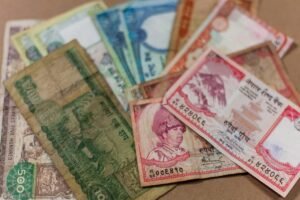China Becomes Go-To for Regional Currency Printing
|
General Studies Paper II: Impact of foreign countries’ policies and politics on India’s interests, India’s Neighbouring Countries |
Why in News?
Recently, Nepal’s central bank has awarded the China Banknote Printing and Minting Corporation (CBPMC) a nearly $17 million contract to design and print 430 million pieces of the 1,000-rupee banknote, highlighting a growing trend of neighboring countries turning to China for currency production.

Nepal’s Currency Printing Decision
- Tender Process: Nepal Rastra Bank (NRB), the central bank of Nepal, publicly invited bids in September 2022 for designing, printing, supplying, and delivering 430 million pieces of its NPR 1,000 banknote. The process was open only to pre-qualified security printers, ensuring that only capable firms could compete. NRB selected the China Banknote Printing and Minting Corporation (CBPMC) because its bid was the lowest evaluated among competitors.
- Contract Details: On 7 November 2025, NRB issued a Letter of Intent to CBPMC for the contract. The agreed cost for the project is USD 16.985 million, according to the Currency Management Department of NRB. The scope includes printing, designing, supplying, and delivering the banknotes.
- Track Record: Nepal first awarded CBPMC a currency‑printing contract in 2016, for 200 million NPR 1,000 notes. Since then, the Chinese firm has printed several denominations, including Rs 5, Rs 10, Rs 100, and Rs 500 notes, under multiple NRB tenders. Over roughly the last three years, CBPMC has won seven consecutive banknote‑printing contracts from Nepal, totaling about 2.38 billion pieces of notes and earning around USD 63 million.
- Economic Implications: Nepal does not have high‑security banknote printing facilities, so NRB outsources the entire printing job, which includes transport, security, and other logistics. In the fiscal year 2021–2022, NRB’s total annual cost for note printing and distribution was NPR 2,403.7 million. By choosing the lowest bidder, Nepal saves on printing costs.
China Banknote Printing and Minting Corporation (CBPMC)
- China Banknote Printing and Minting Corporation (CBPMC) is a state‑owned enterprise directly under the People’s Bank of China. It was founded in 1984, and since then it has grown into a giant in the currency‑production industry.
- CBPMC’s industrial scale is among the largest in the world. It has 23 major subsidiaries, including seven banknote‑printing companies, three mints, two banknote‑paper mills, a security‑thread company, an ink‑making company, a plate‑making company, and seven commercial units.
- CBPMC operates a network of highly secure facilities across China. Its banknote‑printing plants are in Beijing, Shanghai, Chengdu, Xi’an, Shijiazhuang, and Nanchang. Its mints are in Shanghai, Shenyang, Nanjing, and Shenzhen, which produce circulating coins and commemorative ones.
- On the anti-counterfeiting front, CBPMC is very advanced. It makes its own banknote paper through dedicated mills in Baoding, Kunshan, and Chengdu. It also produces security threads, specialized inks, and high‑precision plates.
- CBPMC also builds the printing and minting machinery used in these processes. Its subsidiaries manufacture equipment for the full currency production chain, from offset printing to plate-making, to minting machines. It even offers cash lifecycle services, handling old notes, shredding, and recycling.
- It has produced banknotes for nations like Thailand, Bangladesh, Sri Lanka, Malaysia, Brazil, and others. Many of these contracts come from countries tied to China’s Belt and Road Initiative, where China offers cost‑effective and high-security currency‑printing services.
Regional Trend: Neighboring Countries Opting for China
- Several countries in South Asia and Southeast Asia have increasingly chosen China for currency printing over the past two decades, reflecting growing trust in Chinese technology and reliability.
- Bangladesh has been printing its Taka currency in China since 2010. The move was motivated by the need for affordable printing and the inclusion of modern security features to reduce counterfeiting risks.
- Sri Lanka started relying heavily on China for its Rupee banknotes from 2015. This ensured the integrity of currency circulation and helped reduce counterfeit incidents significantly. After 2019 Sri Lanka signed multiple bilateral currency swap arrangements with the People’s Bank of China. These deals included printing support, enhancing the island nation’s capacity to maintain liquidity.
- Afghanistan began outsourcing its Afghani banknotes to China in the early 2000s. The political instability and limited domestic printing infrastructure made China an attractive partner.
- Bhutan remains an exception, however, recent discussions indicate that Bhutan is considering cooperation with China, reflecting the growing influence and regional appeal of Chinese currency printing technology.
- Thailand moved its currency printing to China in 2018. The Thai government valued reliable production at competitive costs. Printing in China also helped Thailand access modern notes and other anti-counterfeit technologies.
- Malaysia transitioned its Ringgit banknotes to China after 2010. China’s polymer note printing significantly reduced counterfeit incidents by nearly 50%. Malaysia benefited from cost savings and enhanced security.
- Myanmar increased reliance on China following the 2020 coup, when domestic and regional political instability made outsourcing essential. Chinese printing facilities provided secure, reliable, and timely currency production.
Why are Neighbouring Countries Opting for China?
- Cost Efficiency and Competitive Pricing: Several neighbouring central banks find CBPMC’s quotes more economical than traditional printers. These cost advantages make China an attractive partner for smaller economies that have limited printing capacity at home.
- Advanced Security Technology: CBPMC offers modern anti‑counterfeiting features, including holographic threads, color-shifting inks, and watermark technologies. These features strengthen trust in banknote integrity.
- Political and Strategic Calculations: For some countries, the decision to use a Chinese printer is not purely economic. In Nepal’s case, its new notes depict disputed border territories with India, making it politically awkward for India to handle their printing.
- Growing Trust in China’s Global Role: Beyond South Asia, CBPMC has reportedly printed currencies for other countries like Thailand, Malaysia, and Brazil. This track record builds confidence in China’s capability to deliver large-scale, secure printing services.
- Soft Power and Economic Integration: This trend aligns with China’s broader strategy under the Belt and Road Initiative. By offering currency‑printing services, China deepens its economic footprint and forges trust-based financial ties with partner countries.
- Operational Reliability and Capacity: CBPMC is very large and well-resourced. It has a capacity to handle big contracts reliably. For countries with rising currency demands, this capacity ensures timely delivery without compromising quality.
Implications for India
- Geopolitical Shift: China’s role in printing currency for Nepal, Bangladesh, and Sri Lanka enhances its regional influence. India, traditionally the dominant partner in South Asia, sees a shift as Beijing gains soft power leverage through financial and technical collaboration. This may affect India’s ability to influence monetary or diplomatic decisions in these countries.
- Economic Competitiveness: Indian security printing firms like Security Printing and Minting Corporation of India (SPMCIL) are losing contracts to China. This signals a need for India to upgrade technology and pricing models to remain competitive, or risk losing regional contracts permanently.
- Strategic Sensitivities: Some currency designs include territorial depictions or national symbols. Outsourcing printing to China allows countries like Nepal to bypass Indian oversight, which could heighten India’s strategic vulnerability in sensitive border-related symbolism or disputes.
- Regional Trade Relations: Currency printing contracts can influence broader economic cooperation, such as trade and cross-border financial operations. India’s reduced involvement may weaken its traditional economic ties and create openings for China to integrate partner economies more closely with its Belt and Road Initiative (BRI) network.
- Technology and Security: India must be aware that China controls access to advanced anti-counterfeiting technologies in these contracts. Regional countries using Chinese printing may adopt security features India cannot directly monitor, potentially affecting trust in financial instruments used in cross-border trade.
- Diplomatic Responses: India may need to re-evaluate its regional policy to maintain influence. This could involve upgrading its printing capacity, offering competitive packages to neighbours, or strengthening bilateral agreements to balance China’s growing economic footprint. Strategic diplomacy may also include soft-power initiatives beyond finance, such as technology sharing or cultural collaborations.
|
Also Read: Iran’s Currency Reform Plan |








